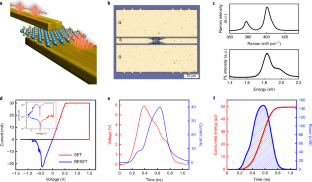2022-06-02 テキサス大学オースチン校(UT Austin)
『Nature Electronics』誌に掲載された論文で、研究チームは、データを受信する際にネットワークや周波数を飛び越え、機器の接続を維持する役割を担う新しい無線周波数スイッチを実証しました。
現在のほとんどの電子機器に存在するスイッチとは対照的に、これらの新しいデバイスは二次元材料で作られており、動作に必要なエネルギーが大幅に少ないため、デバイスの速度とバッテリー寿命が向上することになります。
<関連情報>
- https://news.utexas.edu/2022/06/02/6g-component-provides-speed-efficiency-needed-for-next-gen-network/
- https://www.nature.com/articles/s41928-022-00766-2
6G通信システム用単層二硫化モリブデンスイッチ Monolayer molybdenum disulfide switches for 6G communication systems
Myungsoo Kim,Guillaume Ducournau,Simon Skrzypczak,Sung Jin Yang,Pascal Szriftgiser,Nicolas Wainstein,Keren Stern,Henri Happy,Eilam Yalon,Emiliano Pallecchi & Deji Akinwande
Nature Electronics Published:DOI:https://doi.org/10.1038/s41928-022-00766-2

Abstract
Atomically thin two-dimensional materials—including transitional metal dichalcogenides and hexagonal boron nitride—can exhibit non-volatile resistive switching. This switching behaviour could be used to create analogue switches for use in high-frequency communication, but has so far been limited to frequencies relevant to the fifth generation of wireless communication technology. Here we show that non-volatile switches made from monolayer molybdenum disulfide in a metal–insulator–metal structure can operate at frequencies corresponding to the sixth-generation communication band (around 100–500 GHz). The switches exhibit low insertion loss in the ON state and high isolation in the OFF state up to 480 GHz with sub-nanosecond pulse switching. We obtain the eye diagrams and constellation diagrams at various data transmission rates and modulations to evaluate the device performance, including real-time data communication up to 100 Gbit s−1 at a carrier frequency of 320 GHz, with a low bit error rate and high signal-to-noise ratio.



